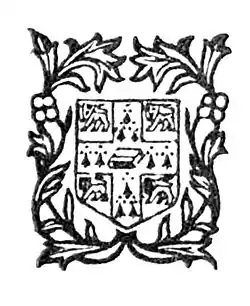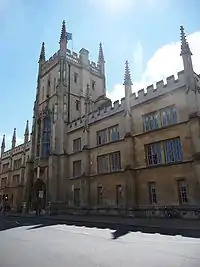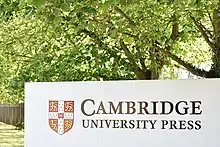Cambridge University Press
Cambridge University Press (CUP) is the publishing business of the University of Cambridge. Granted letters patent by King Henry VIII in 1534, it is the oldest university press in the world.[2][3][4][5] It is also the Queen's Printer.[6]
| Parent company | University of Cambridge |
|---|---|
| Status | Active |
| Founded | 1534 |
| Founder | King Henry VIII of England |
| Country of origin | United Kingdom |
| Headquarters location | Cambridge, England |
| Distribution | self-distributed Ingram Content Group (US fulfillment) DHL Supply Chain (UK fulfillment)[1] |
| Key people | Stephen Toope, Peter Phillips |
| Nonfiction topics | Humanities; Social Sciences; Science; Medicine; Engineering and Technology; English Language Teaching and Learning; Education; Bibles |
| Revenue | £336 million (2020) |
| No. of employees | 3,039; 58 per cent are outside the UK |
| Official website | www |

Cambridge University Press is a department of the University of Cambridge and is both an academic and educational publisher. With a global sales presence, publishing hubs, and offices in more than 40 countries, it publishes over 50,000 titles by authors from over 100 countries. Its publishing includes more than 380 academic journals, monographs, reference works, school and university textbooks, and English language teaching and learning publications. It also publishes Bibles, runs a bookshop in Cambridge, sells through Amazon, and has conference venues business in Cambridge at the Pitt Building and the Sir Geoffrey Cass Sports and Social Centre. Being part of the University of Cambridge gives CUP a non-profit status. CUP transfers a minimum of 30% of any annual surplus back to the University of Cambridge.[7]
History


Cambridge University Press is the oldest university press in the world. It originated from letters patent granted to the University of Cambridge by Henry VIII in 1534. Cambridge is one of the two privileged presses (the other being Oxford University Press). Authors published by Cambridge have included John Milton, William Harvey, Isaac Newton, Bertrand Russell, and Stephen Hawking.[8]
University printing began in Cambridge when the first practicing University Printer, Thomas Thomas, set up a printing house in 1584.[4] In July 1697 the Duke of Somerset made a loan of £200 to the university "towards the printing house and press" and James Halman, Registrary of the University, lent £100 for the same purpose.[9]
The press began using steam-powered machine presses by the 1850s. It was in this period that the Press turned down what later became the Oxford English Dictionary – a proposal for which was brought to Cambridge by James Murray before he turned to Oxford.[8]
In 1975 the Press launched its English language teaching publishing business.[10] In 1981 the Press built a new purpose-built building named The Edinburgh Building with its adjoining warehouse to accommodate the Press's expansion. This site was sold to Cambridge Assessment in 2015 for the construction of The Triangle Building.
In 1986 the Press acquired the long-established Bible and prayer book publisher Eyre & Spottiswoode, which gave the Press the ancient and unique title of 'The Queen's Printer'.[11]
In 1992 the Press opened a bookshop at 1 Trinity Street. It the oldest known bookshop site in Britain.[12] In 2008 the shop expanded into 27 Market Hill where its specialist Education and English Language Teaching shop opened the following year. The Press bookshop showcases Press books as well as selling a wide selection of gifts, including mugs, diaries, bags, postcards, maps, and other Cambridge souvenirs.[13]
In 2012 the Press sold its printing operation to MPG Books Group[14] and CUP now uses third parties around the world to provide its print publications.
Relationship with the University of Cambridge

CUP is a non-teaching department of the University of Cambridge. The Press has, since 1698, been governed by the Press 'Syndics' (originally known as the 'Curators'),[15] 18 senior members of the University of Cambridge who, along with other non-executive directors, bring a range of subject and business expertise.[16] The Chair of the Syndicate is currently Professor Stephen Toope (Vice-Chancellor of the University of Cambridge). The Syndicate has delegated its powers to a Press & Assessment Board; and to an Academic Publishing Committee and an English Language Teaching & Education Publishing Committee.[17]
The Press & Assessment Board is responsible for setting overarching strategic direction.[17] The Publishing Committees provide quality assurance and formal approval of the publishing strategy.[17]
The operational responsibility of the Press is delegated by the Syndics to the Secretary of the Syndicate and Chief Executive.
Organisational structure
Cambridge University Press comprises three publishing groups and a shared services group. These are:
Academic Publishing
This group publishes research books and journals in science, technology, medicine, humanities, and the social sciences.[18] It also publishes advanced learning materials and reference content as well as 380 journals, of which 43 are ‘Gold’ Open Access. Open Access articles now account for 15 per cent of articles. The group also publishes Bibles, and the Press is one of only two publishers entitled to publish the Book of Common Prayer and the King James Version of the Bible in England.[19]
English Language Teaching
ELT publishes English language teaching courses and resources for learners of all ages around the world.[18] It offers a suite of integrated learning and assessment tools underpinned by the Cambridge Curriculum, a systematic approach to learning and evaluating proficiency in English. It works closely with Cambridge Assessment through the joint initiative Cambridge Exams Publishing.
Education
The Education group delivers educational products, services and software for primary, secondary and international schools. It collaborates with Cambridge Assessment and the University of Cambridge Faculty of Education to help countries such as Kazakhstan and Oman to improve their education systems. It also works with Cambridge Assessment to reach more schools and develop new products and services that improve teaching and learning.
Shared Services
Shared services functions include Customer Services, Finance, Technology, Operations, HR and Legal.
Partnerships and acquisitions
- In 2011, Cambridge University Press formed a partnership with Cambridge Assessment to publish official Cambridge preparation materials for Cambridge English and IELTS examinations.
- In 2015, Cambridge University Press formed a strategic content and technology partnership with Edmodo, the world's most extensive e-learning platform for primary and secondary teachers and pupils, to bring premier educational content and technology to schools in the United Kingdom.[20]
- In 2017, the University of Cambridge announced that Cambridge University Press and Cambridge Assessment would work more closely in future under governance by the Press & Assessment Board.
- In 2019, Cambridge University Press and Cambridge Assessment English acquired the Centre for Evaluation and Monitoring from Durham. CEM provides assessments to measure learner progress and potential, as well as 11 Plus exams for many UK independent and grammar schools.[21]
- In 2020, CUP partnered with EDUCATE Ventures, the University College London edtech accelerator, to better understand the challenges and successes of home education during the lockdown.[22]
- In 2020, CUP partnered with online library Perlego to offer students access to digital textbooks.[23]
- In October 2020, CUP announced it would create a 'new unified organization' by merging with Cambridge Assessment, to launch 1 August 2021.[24]
Digital developments

In 2011, Cambridge University Press (CUP) adopted SAP. In January 2013, the finance and procurement model of SAP was implemented. The sales and distribution model of SAP is now being implemented. Cambridge University Press works closely with IT services firm Tech Mahindra on SAP, and with Cognizant and Wipro on other systems.[25][26]
In 2016, Cambridge Books Online and Cambridge Journals Online were replaced by Cambridge Core which provided significantly enhanced interfaces and upgraded navigation capabilities, as well as article-level and chapter-level content selection.[27] A year after Cambridge Core went live, the Press launched Cambridge Core Share, functionality to allow users to generate and share links with free access to selected journal articles, an early sign of the Press's commitment to open research.[28]
Controversies
Alms for Jihad
In 2007, controversy arose over the Press's decision to destroy all remaining copies of its 2006 book Alms for Jihad: Charity and Terrorism in the Islamic World, by Burr and Collins, as part of the settlement of a lawsuit brought by Saudi billionaire Khalid bin Mahfouz.[29] Within hours, Alms for Jihad became one of the 100 most sought after titles on Amazon.com and eBay in the United States. The Press sent a letter to libraries asking them to remove copies from circulation. The Press subsequently sent out copies of an "errata" sheet for the book.
The American Library Association issued a recommendation to libraries still holding Alms for Jihad: "Given the intense interest in the book, and the desire of readers to learn about the controversy first hand, we recommend that U.S. libraries keep the book available for their users." The publisher's decision did not have the support of the book's authors and was criticized by some who claimed it was incompatible with freedom of speech and with freedom of the press and that it indicated that English libel laws were excessively strict.[30][31] In a New York Times Book Review (7 October 2007), United States Congressman Frank R. Wolf described Cambridge's settlement as "basically a book burning".[32] The Press pointed out that, at that time, it had already sold most of its copies of the book.
The Press defended its actions, saying it had acted responsibly and that it is a global publisher with a duty to observe the laws of many different countries.[33]
Cambridge University Press v. Patton
In this case, originally filed in 2008, final judgment pending, CUP et al. accused Georgia State University of infringement of copyright.[34]
China Quarterly
On 18 August 2017, following an "instruction" from a Chinese import agency, Cambridge University Press used the functionality that had been built into Cambridge Core to temporarily delete politically sensitive articles from the China Quarterly on its Chinese website. The articles focused on topics China regards as taboo, including the 1989 Tiananmen massacre, Chairman Mao Zedong’s Cultural Revolution, Hong Kong's fight for democracy and ethnic tensions in Xinjiang and Tibet.[35][36][37][38]
On 21 August 2017, in the face of growing international protests, CUP announced it would immediately repost the articles to uphold the principle of academic freedom on which the University's work is founded.[39][40]
Community work

The Press undertakes substantial community engagement with the local community and around the world where there are Press employees. In 2016, some of the Press's community works included its continued support to Westchester Community College in New York, the installation of hygienic facilities in an Indonesian rural school, raising funds to rehabilitate earthquake-stricken schools in Nepal and guiding students from Coleridge Community College, Cambridge in a CV workshop. On World Book Day 2016, the Press held a digital Shakespeare publishing workshop for students and their teachers. Similarly, their Indian office conducted a workshop for teachers and students in 17 schools in Delhi to learn the whole process of book publishing. The Press donated more than 75,000 books in 2016.[41] Annually, the Press selects their UK Charity of the Year, which has included local charities Centre 33 (2016 and 2017), Rowan Humberstone (2018) and Castle School (2019).
An apprenticeship program for people interested in careers in publishing was established in 2016.[42]
Environment
The Press monitors its emissions annually, has converted to energy-saving equipment, minimizes plastic use and ensures that their paper is sourced ethically.[43] In 2019, the World Wildlife Fund awarded its highest score to the Press of Three Trees, based on the Press's timber purchasing policy, performance statement and its responsible sourcing of timber.[44] The Press works hard to minimise the number of books that are sent for pulping each year.
Open access
Cambridge University Press has stated its support for a sustainable transition to open access.[45] It offers a range of open access publishing options under the heading of Cambridge Open, allowing authors to comply with the Gold Open Access and Green Open Access requirements of major research funders. It publishes Gold Open Access journals and books and works with publishing partners such as learned societies to develop Open Access for different communities. It supports Green Open Access (also called Green archiving) across its journals and monographs, allowing authors to deposit content in institutional and subject-specific repositories. It also supports sharing on commercial sharing sites through its Cambridge Core Share service.
In recent years it has entered into several Read & Publish Open Access agreements with university libraries and consortia in several countries, including a landmark agreement with the University of California.[46][47] In its 2019 Annual Report, Cambridge University Press stated that it saw such agreements "as an important stepping stone in the transition to Open Access."[48]
In 2019, the Press joined with the University of Cambridge's research and teaching departments to give a unified response to Plan S, which calls for all publications resulting from publicly-funded research to be published in compliant open access journals or platforms from 2020. The response emphasized Cambridge's commitment to an open access goal which works effectively for all academic disciplines, is financially sustainable for institutions and high-quality peer review, and which leads to an orderly transition.[49]
The Press is a member of the Open Access Scholarly Publishers Association and the International Association of STM Publishers.
Publications
In 2019, the Press released a new concept in scholarly publishing through Cambridge Elements where authors whose works are either too short to be printed as a book or too long to qualify as a journal article can have them published within 12 weeks.[50]
References
Citations
- "Cambridge announces tenth successive year of growth". Cambridge University Press. Retrieved 6 February 2018.
- "Oldest printing and publishing house". Guinnessworldrecords.com. 22 January 2002. Retrieved 28 March 2012.
- Black, Michael (1984). Cambridge University Press, 1583–1984. pp. 328–9. ISBN 978-0-521-66497-4.
- "A Brief History of the Press". Cambridge University Press. Retrieved 3 August 2018.
- "About Oxford University Press". OUP Academic. Retrieved 3 August 2018.
- "The Queen's Printer's Patent". Cambridge UNiversity Press. Retrieved 20 March 2016.
- "University of Cambridge Financial Statements" (PDF).
- Black, Michael (2000). Cambridge University Press, 1584–1984. Cambridge University Press. ISBN 978-0-521-66497-4.
- The Cambridge University Press 1696—1712 (CUP, 1966), p. 78
- "Timeline". Cambridge University Press. Retrieved 26 July 2019.
- Black, Michael; Black, Michael H. (28 March 2000). A Short History of Cambridge University Press. Cambridge University Press. ISBN 978-0-521-77572-4.
- "History of the Bookshop". Cambridge University Press Bookshop. 2009. Retrieved 16 January 2018.
- "Our Bookshop". Cambridge University Press. Retrieved 30 June 2020.
- "Cambridge University Press ends printing after 400 years | The Bookseller". www.thebookseller.com. Retrieved 30 June 2020.
- McKitterick, David (1998). A History of Cambridge University Press, Volume 2: Scholarship and Commerce, 1698–1872. Cambridge University Press. p. 61. ISBN 978-0-521-30802-1.
- "Statutes J – The University Press" (PDF). University of Cambridge. 2010. Archived from the original (PDF) on 7 June 2011. Retrieved 4 May 2011.
- "The Press Syndicate". Cambridge University Press.
- Black, Michael (2000). A Short History of Cambridge University Press. Cambridge University Press. pp. 65–66. ISBN 978-0-521-77572-4.
- "The Queen's Printers Patent". Cambridge University Press Website. Archived from the original on 25 January 2012. Retrieved 15 October 2012.
- "Edmodo and Cambridge University Press Form Strategic Content and Technology Partnership". Cambridge University Press. Retrieved 30 June 2020.
- "Cambridge Assessment Annual Report 2018-19" (PDF).
- "EDUCATE Ventures and Cambridge University Press enter partnership to deliver major study on home learning during pandemic". Cambridge University Press. Retrieved 30 June 2020.
- "Cambridge University Press partners with Perlego on online textbooks | The Bookseller". www.thebookseller.com. Retrieved 16 August 2020.
- "Cambridge University Press merges with Cambridge Assessment | Camrbidge University Press". www.cambridge.org.
- "CIO interview: Mark Maddocks, Cambridge University Press". ComputerWeekly.com. Retrieved 30 June 2020.
- "Tech Mahindra deploys SAP sol for Cambridge University Press". Business Standard India. Press Trust of India. 29 January 2014. Retrieved 30 June 2020.
- Launching Cambridge Core, retrieved 25 July 2019
- Sharing Platform Includes Content Usage Records, retrieved 25 July 2019
- Steyn, Mark (6 August 2007). "One Way Multiculturalism". The New York Sun. Ronald Weintraub. Retrieved 4 May 2011.
- Richardson, Anna (3 August 2007). "Bonus Books criticises CUP". Thebookseller.com. Retrieved 4 May 2011.
- Jaschick, Scott (16 August 2007). "A University Press stands up – and wins". Insidehighered.com. Retrieved 4 May 2011.
- Danadio, Rachel (7 October 2007). "Libel Without Borders". The New York Times. Retrieved 4 May 2011.
- Taylor, Kevin (9 August 2007). "Why CUP acted responsibly". The Bookseller. Retrieved 4 May 2011.
- Hafner, Katie (16 April 2008). "Publishers Sue Georgia State on Digital Reading Matter". The New York Times. ISSN 0362-4331. Retrieved 13 May 2020.
- "《中國季刊》:對中國刪300多篇文章深表關注". 18 August 2017 – via www.bbc.com.
- "Cambridge University Press statement regarding content in The China Quarterly". Cambridge University Press. Retrieved 20 August 2017.
- Millward, James A. (19 August 2017). "Open Letter to Cambridge University Press about its censorship of the China Quarterly". Medium. Retrieved 20 August 2017.
- Phillips, Tom (20 August 2017). "Cambridge University Press censorship 'exposes Xi Jinping's authoritarian shift'". The Guardian. ISSN 0261-3077. Retrieved 20 August 2017.
- Kennedy, Maev; Phillips, Tom (21 August 2017). "Cambridge University Press backs down over China censorship". The Guardian. ISSN 0261-3077. Retrieved 22 August 2017.
- "Cambridge University Press reverses China censorship move". BBC News. 21 August 2017. Retrieved 22 August 2017.
- Annual Report for the year ended 30 April 2016 (PDF), retrieved 25 July 2019
- Annual Report for the year ended 30 April 2017 (PDF), retrieved 25 July 2019
- Annual Report for the year ended 30 April 2018, retrieved 25 July 2019
- WWF Timber Scorecard 2019, retrieved 25 July 2019
- Open Research, retrieved 26 July 2019
- UC and Cambridge University Press Agree to Open Access Publishing Deal, retrieved 26 July 2019
- Kell, Gretchen (11 April 2019), "Post-Elsevier breakup, new publishing agreement 'a win for everyone'", University of California, retrieved 26 July 2019
- Annual Report 2019, Cambridge University Press, retrieved 26 July 2019
- Cambridge Submission to cOAlition S Consultation on Plan S (PDF), retrieved 26 July 2019
- Annual Report for the year ended 30 April 2016 (PDF), retrieved 25 July 2019
Sources
- Anonymous; The Student's Guide to the University of Cambridge. Third Edition, Revised and Partly Re-written; Deighton Bell, 1874 (reissued by Cambridge University Press, 2009; ISBN 978-1-108-00491-6)
- Anonymous; War Record of the Cambridge University Press 1914–1919; Cambridge University Press, 1920; (reissued by Cambridge University Press, 2009; ISBN 978-1-108-00294-3)
- A History of Cambridge University Press, Volume 1: Printing and the Book Trade in Cambridge, 1534–1698; McKitterick, David; 1992; ISBN 978-0-521-30801-4
- A History of Cambridge University Press, Volume 2: Scholarship and Commerce, 1698–1872; McKitterick, David; 1998; ISBN 978-0-521-30802-1
- A History of Cambridge University Press, Volume 3: New Worlds for Learning, 1873–1972; McKitterick, David; 1998; ISBN 978-0-521-30803-8
- A Short History of Cambridge University Press; Black, Michael; 2000; ISBN 978-0-521-77572-4
- Cambridge University Press 1584–1984; Black, Michael, Foreword by Gordon Johnson; 2000; ISBN 978-0-521-66497-4, Hardback ISBN 978-0-521-26473-0
External links
| Wikimedia Commons has media related to Cambridge University Press. |
